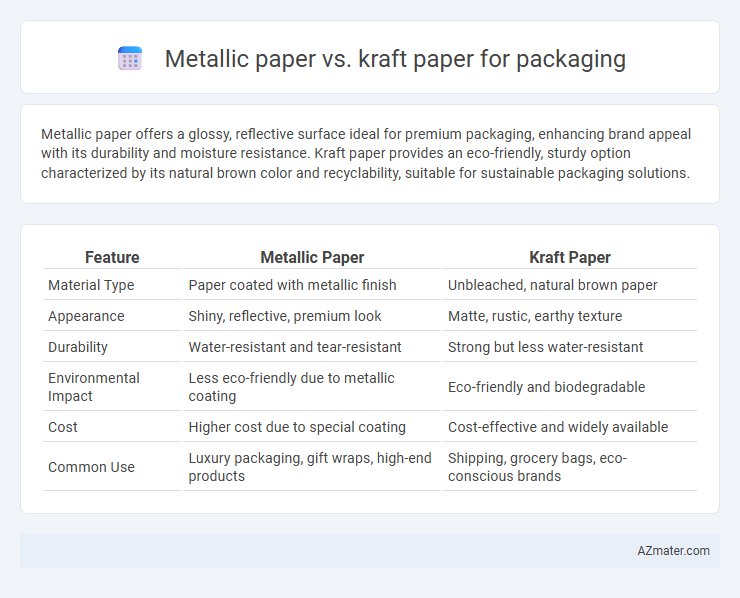Metallic paper offers a glossy, reflective surface ideal for premium packaging, enhancing brand appeal with its durability and moisture resistance. Kraft paper provides an eco-friendly, sturdy option characterized by its natural brown color and recyclability, suitable for sustainable packaging solutions.
Table of Comparison
| Feature | Metallic Paper | Kraft Paper |
|---|---|---|
| Material Type | Paper coated with metallic finish | Unbleached, natural brown paper |
| Appearance | Shiny, reflective, premium look | Matte, rustic, earthy texture |
| Durability | Water-resistant and tear-resistant | Strong but less water-resistant |
| Environmental Impact | Less eco-friendly due to metallic coating | Eco-friendly and biodegradable |
| Cost | Higher cost due to special coating | Cost-effective and widely available |
| Common Use | Luxury packaging, gift wraps, high-end products | Shipping, grocery bags, eco-conscious brands |
Introduction to Metallic Paper and Kraft Paper
Metallic paper features a glossy, reflective surface often coated with aluminum, providing excellent print quality and premium aesthetics ideal for luxury packaging and high-end product presentation. Kraft paper is a durable, eco-friendly material made from wood pulp with a natural brown color, widely used for its strength, recyclability, and rustic appearance in sustainable packaging solutions. Both materials serve distinct packaging purposes, with metallic paper emphasizing visual appeal and kraft paper prioritizing environmental benefits and sturdiness.
Composition and Material Properties
Metallic paper consists of a cellulose base coated with a thin layer of aluminum or other metals, offering high gloss, superior light reflectivity, and excellent barrier properties against moisture and oxygen. Kraft paper is made from wood pulp fibers in a chemical process that produces strong, durable, and biodegradable material with high tear resistance and porosity. The metallic coating on metallic paper enhances aesthetic appeal and protective functionality, while Kraft paper excels in sustainability and recyclability due to its natural fiber composition.
Visual Appeal and Aesthetics
Metallic paper offers a sleek, reflective surface that enhances brand visibility with its shiny, eye-catching finish, ideal for premium packaging. Kraft paper provides a natural, rustic look with a textured matte surface, appealing to eco-conscious consumers and conveying authenticity. The choice between metallic and kraft paper directly influences packaging aesthetics by balancing modern luxury against organic simplicity.
Strength and Durability Comparison
Metallic paper offers superior strength and durability due to its multi-layer coating, which provides resistance to moisture, tearing, and abrasion, making it ideal for premium and protective packaging. Kraft paper, while highly durable and tear-resistant due to its natural fiber composition, excels in environmental sustainability and flexibility but may lack the moisture resistance and premium finish of metallic paper. For applications requiring robust protection and aesthetic appeal, metallic paper outperforms Kraft paper in maintaining structural integrity under stress.
Environmental Impact and Sustainability
Metallic paper, often coated with aluminum or synthetic layers, presents significant environmental challenges due to its complex recycling process and reduced biodegradability, whereas kraft paper, made from natural wood fibers, is widely recognized for its eco-friendliness and ease of recycling. Kraft paper's production typically involves fewer chemicals and lower energy consumption, contributing to reduced carbon emissions compared to metallic paper. Sustainable packaging solutions increasingly favor kraft paper for its renewability and biodegradability, aligning with circular economy principles and minimizing landfill waste.
Printability and Customization Options
Metallic paper offers superior printability with vibrant color reproduction and a glossy finish that enhances brand visibility, making it ideal for high-impact packaging designs. Kraft paper provides a rustic, natural aesthetic with excellent durability, supporting customization through eco-friendly inks and embossing techniques, though its print quality is generally matte and subdued. Both materials cater to distinct branding needs, with metallic paper excelling in premium visual appeal and kraft paper emphasizing sustainability and texture customization.
Cost-Efficiency and Budget Considerations
Metallic paper offers a premium finish with high visual appeal but tends to be more expensive due to specialized coatings and production processes, affecting overall packaging budgets. Kraft paper provides an eco-friendly, cost-effective alternative with durable strength suitable for bulk packaging, making it ideal for budget-conscious businesses. Choosing between metallic and kraft paper hinges on balancing visual impact against cost-efficiency, where kraft paper often delivers superior value in large-scale or sustainable packaging applications.
Applications in Packaging Industries
Metallic paper is widely used in luxury packaging, food wrapping, and cosmetic boxes due to its reflective surface that enhances product appeal and provides moisture resistance. Kraft paper is preferred for eco-friendly and durable packaging solutions such as shopping bags, food pouches, and heavy-duty wrapping, offering tear resistance and biodegradability. Packaging industries leverage metallic paper for premium product presentation and kraft paper for sustainability and strength in everyday packaging applications.
Consumer Perception and Brand Value
Metallic paper enhances consumer perception by conveying luxury and sophistication, often associated with high-end brands, which can elevate brand value significantly in competitive markets. Kraft paper, valued for its natural, eco-friendly appearance, appeals to environmentally conscious consumers and strengthens brand identity focused on sustainability. Brands leveraging metallic paper often gain premium positioning, while those using kraft paper build trust through authenticity and environmental responsibility.
Choosing the Right Paper for Your Packaging Needs
Metallic paper offers a glossy, high-end appearance ideal for luxury packaging, enhancing visual appeal and shelf impact, while kraft paper provides eco-friendly, durable, and cost-effective packaging suited for rustic or natural branding. Evaluating factors such as product protection, brand image, environmental sustainability, and budget helps determine the best choice between metallic and kraft paper. Opt for metallic paper for premium presentation and kraft paper for strength and ecological benefits in packaging.

Infographic: Metallic paper vs Kraft paper for Packaging
 azmater.com
azmater.com